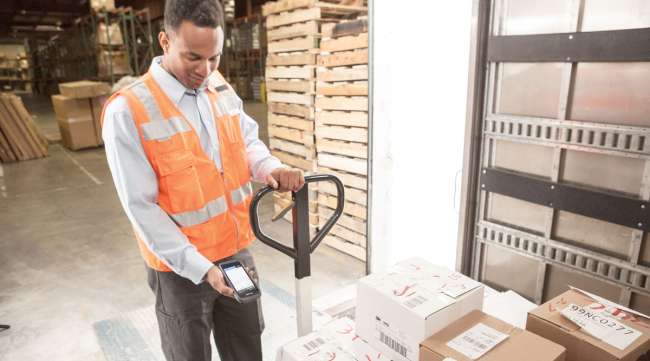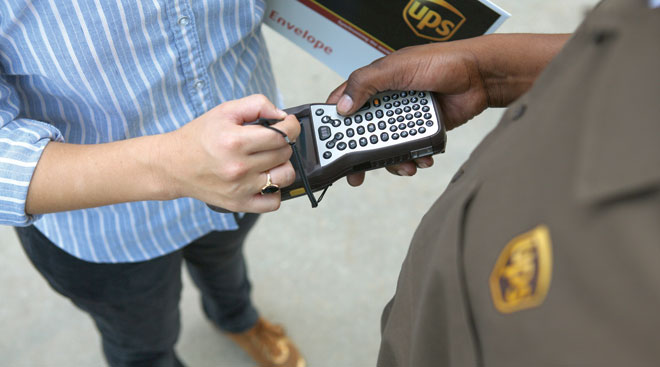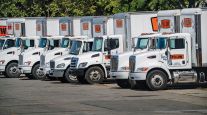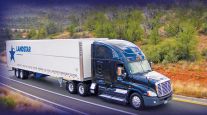Industrial Handhelds Maintain Niche in LTL Despite Ubiquity of Consumer Mobile Devices

The immense popularity of Android and Apple smartphones and tablets has led many truckload carriers to deploy mobile applications that drivers can run on those consumer devices.
The less-than-truckload world, however, is another matter.
Major LTL carriers said industrial handhelds offer critical advantages to their drivers, including their ruggedized construction and longer battery life.
Three years ago, drivers for all four major divisions of YRC Worldwide were using an Intermec handheld that had a keyboard and ran on a Windows operating system.
Today, YRC Freight, the company’s national LTL operating unit, is using a Panasonic Toughpad, a ruggedized handheld that runs on Android.
The company’s three regional carriers — Reddaway, New Penn and Holland — are using a rugged Honeywell handheld that also runs on Android. Honeywell acquired Intermec in 2013.
“We knew we needed an industrial device,” said Jason Ringgenberg, chief information officer for YRC Worldwide. “It’s really the ruggedness. Dropping is probably the single greatest hazard. The consumer devices are just not going to hold up.”
Even though YRC may have chosen industrial handhelds over consumer devices, Ringgenberg said the industry is “reaping huge rewards because of the smartphone wave.” The volume of consumer devices sold is bringing component prices down and fostering advancements in software, he said.

UPS Inc.
“New industrial handhelds are thinner and lighter,” Ringgenberg said. “They have bigger screens, and they don’t have mechanical keyboards. The flash memory is less expensive. The chipsets are faster. The screens are brighter.”
The list of technological advances goes on, including better form factors, batteries that last longer, far better 4G LTE coverage, far better speeds on those networks and falling data prices.
“None of this would have been possible without the millions and millions of people each year who carry smartphones in their pockets,” Ringgenberg said. “This is all because of the consumer revolution in mobile devices. It’s been a huge benefit for our industry.”
YRC, which is based in Overland Park, Kan., ranks No. 5 on the Transport Topics Top 100 list of the largest for-hire carriers in North America.
Drivers for ArcBest also use a ruggedized industrial handheld, said Michael Newcity, senior vice president and chief innovation officer of ArcBest Corp. and president of ArcBest Technologies, an ArcBest subsidiary.
“Our drivers are using the Zebra TC75,” he said. “In our environment, these devices are exposed to extreme elements such as heat, cold, vibration, dust, moisture and physical wear.”
Zebra Technologies acquired Motorola Solutions’ handhelds business in 2014.
Fort Smith, Ark.-based ArcBest, the parent of ABF Freight, ranks No. 12 on the for-hire TT100.
In addition to their ability to withstand the demands of rough handling and harsh environments, industrial handhelds offer an assortment of features not found in the typical consumer device.
The primary device used by UPS Inc. drivers for small-package pickup and delivery operations is made by Honeywell and is known as the Delivery Information Acquisition Device, or DIAD.
The DIAD V, the handheld’s fifth version, was chosen for its “device ruggedness, high-grade imager for scanning performance, extended battery life and multi-SIM capabilities for communication redundancy,” said John Brelesky, director of global package mobility solutions for UPS.
The Honeywell industrial handheld used by FedEx Freight also offers dual SIM cards, which makes it possible to switch from one cellular network to another, said Sean Healy, senior vice president of strategic planning and engineering at FedEx Freight.
This feature offers a big advantage in terms of being able to maximize access and keep drivers connected anywhere along their routes, he said.
UPS and FedEx Corp. rank Nos. 1 and 2, respectively, on the for-hire TT100.
Brelesky sees the markets for consumer devices and industrial handhelds converging because of the demand for a single device that does it all. Such a device will leverage web-based services, turn-by-turn navigation, integration with internet-of-things devices, voice capabilities and more, he said.
Even though the purchase price for consumer devices may be lower, the total cost of ownership for industrial handhelds is often better, ArcBest’s Newcity said.
Healy agreed.
“The difference in total cost of ownership between an industrial and a consumer device is minimal, and therefore isn’t a major factor in our decision,” he said. “In fact, our estimates show the consumer device will be slightly costlier compared to the life of an industrial product.”
Representatives from Honeywell, Zebra and Panasonic also emphasized battery life, bar code scanning and the ability to replace batteries easily as reasons that companies would choose industrial handhelds over consumer devices.
“Enterprise devices have more powerful batteries, which extends the working day of a device before it will need to be recharged,” said Justine Clark, transport and logistics marketing manager for Honeywell.
If a battery does run down, it can be quickly and easily replaced, which is a “key factor for industrial handhelds,” she said. For consumer devices, “this is often an extremely difficult task — especially in the field.”
Bar code scanning is another area where industrial handhelds have a clear edge on consumer products.
“Consumer smartphones and tablets are not optimized for entering data,” Clark said.
Industrial handhelds “allow for snappy scanning from different angles and the ability to read damaged bar codes,” she said.
Clark also pointed out that industrial handhelds “tend to be more ergonomic and designed to be comfortable for a long shift” and that they “tend to have a longer life cycle than consumer devices.”
Consumer devices aren’t made to withstand the frequency of use that work situations may present, said Mike Maris, senior director of transportation and logistics for Zebra Technologies.
“For example, if you are repeatedly plugging a charging cord into a consumer device throughout the day to prevent the battery from dying, the charging port will wear out prematurely,” he said.
Zebra’s handhelds have adopted the touchscreens that became popular in consumer devices, but the company has taken the technology a step further, Maris said.
“Try to use your iPhone or a Samsung smartphone with a pair of leather gloves on,” he said. “You can’t. With a Zebra device, you can do that.”
Another major change that has taken place at Zebra involved advanced technology for acquiring data from bar codes.
“We’ve gone from scanners to imagers,” Maris said.
Imagers are fast cameras that can take an image of the bar code.
“If the bar code is smudged or covered up a little bit, the imager technology can adjust it,” he said.
The imagers also can function as close as 7 inches or as far away as 40 feet. “And the imagers can read 2D bar codes, which scanners can’t handle at all,” Maris said.
A Zebra feature called SimulScan makes it possible to read multiple bar codes at once. The information is then parsed out to the appropriate fields in the application.
“For example, the consignee number can be read and then electronically assigned to the correct field in a form within an application,” Maris said.
A task that previously required a worker to sift through paperwork and transfer data manually now can be handled almost instantly.
Maris admitted that the lower prices of consumer devices had driven Zebra to create an assortment of products with a wider range of prices.
“Some of our customers don’t need a device that can handle subzero temperatures,” he said.
“But it is important to remember the total cost of ownership,” he added. “If that consumer device breaks during someone’s shift, there are all kinds of costs associated with that breakdown.”
Michael Smola, director of enterprise mobility sales for Panasonic, said industrial handhelds can offer the advantage of providing features designed for specific industries.
“The natural path of technology has driven us all to want smaller devices,” Smola said. “Because new technology has developed smaller, more powerful processors, we now have the ability to make highly configured devices and put them in a smaller package.”
While consumer devices aim to be one-size-fits-all, Panasonic’s devices are “purpose-built and configured to act as a tool for our customers,” he said.
Although industrial handhelds have clear advantages for some companies in transportation and logistics, there are use cases in which consumer devices may have the upper hand.
“The one area where I think consumer devices have a chance to work will be in the Uber type of market,” Zebra’s Maris said. “People working in this area are often doing so part time, and they are independent contractors.”
The part-time nature of their work means that they might prefer to use the same device for work that they use for their personal life, Maris said. “They aren’t going to have an enterprise device for this use case.”
Honeywell’s Clark made a similar observation.
“A bicycle courier in a major city would likely use a smartphone to make deliveries,” she said. “But, a driver for a large freight company would likely need an enterprise device, which may be subject to drops, bright light and rain, and need a long battery life.”




